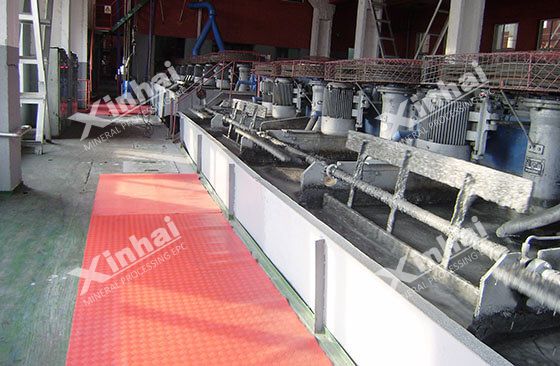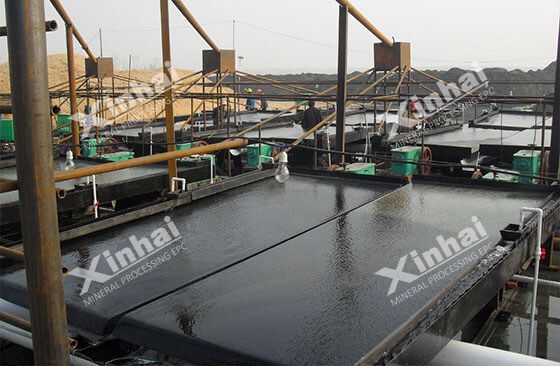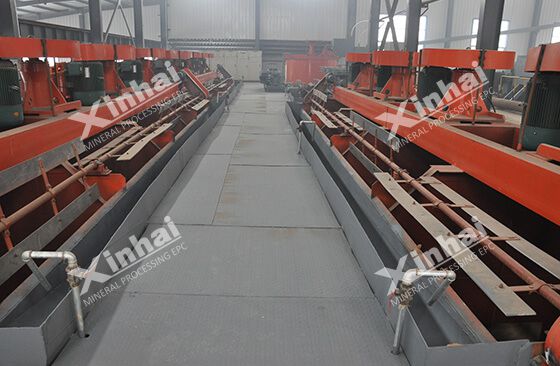
Due to the different types and contents of valuable components in lead-zinc ore tailings, and their respective occurrence states, it is necessary to adopt a suitable lead-zinc tailings re-selection process according to their specific properties. The following introduces several recycling processes of lead-zinc ore tailings with different valuable components in lead-zinc ore tailings.

Spiral chute desliming-Shaker enrichment- Gravity selection-flotation
For the recovery of zinc oxide, the sludge must be controlled, because the sludge inhibits the floatability of zinc minerals, leading to a sharp increase in the amount of flotation reagents. Spiral chute is a relatively good desliming equipment, which has the advantages of simple maintenance and high unit processing capacity. It can slightly enrich zinc when desliming a large amount of sludge. The coarse concentrate obtained by using a single spiral chute contains low zinc grade, and the cost of flotation is higher if it is directly carried out. Therefore, the coarse concentrate obtained from the spiral chute is enriched by a shaking table to obtain a higher grade zinc oxide coarse concentrate, which will help the subsequent flotation process to obtain better concentrate indicators.

Flotation- Weak magnetic separation- Flotation
The lead-zinc tailings contain difficult-to-select pyrrhotite so that the iron concentrate contains excessive sulfur. Therefore, sulfur recovery must be strengthened to reduce the harmful sulfur content in the iron concentrate. Sulfur-containing minerals such as pyrrhotite easily enter the iron concentrate during magnetic separation and become harmful components. Therefore, the flotation process first adopts rough separation process to desulfurize the pyrrhotite and strengthen the activation and collection of pyrrhotite. The activation and collection of the ore can reduce pyrrhotite enters the next magnetic separation operation, and play a key role in reducing the sulphur content of the iron concentrate. The concentrate obtained from magnetic separation enters the flotation operation again, and finally obtains high-grade high-quality sulphur concentrate and qualified iron concentrate.

Desliming-Desulfurization flotation-Flotation tailings regrind-Barite flotation
Excessive sludge in the lead-zinc ore tailings is easy to compete with barite for adsorption, which increases the consumption of collectors. In addition, it also causes the flotation foam to become sticky, reduces the flotation selectivity, and is not conducive to increase the grade of barite. So it is necessary to pre-desludge before barite flotation. In addition to barite, lead-zinc tailings will also contain a small amount of pyrite. Conventional anionic collectors also have a collection effect on sulfide ore. Therefore, we need to remove the pyrite by flotation before barite flotation. The barite minerals in the flotation tailings are complex and intergrowth with other minerals. In order to obtain high-grade barite concentrates, regrind operations are required to increase the monomer dissociation degree of barite, so we adopt these processes of desliming, desulfurization flotation-flotation tailings regrind and barite flotation to recover barite from lead-zinc tailings.

Lead-zinc ore tailings desulfurization- Strong magnetic separation for desulfurization tailings
The recoverable manganese minerals in lead-zinc ore tailings are manganese carbonate minerals, which are weakly magnetic. In general, the magnetic susceptibility of manganese carbonate ore increases with the increase of manganese grade. Due to there have a certain amount of iron, which easy to result remanence, so a high-gradient strong magnetic separator is used to recover manganese minerals. Because lead-zinc ore tailings still contain a small amount of sulfur, the flotation process is first used to desulfurize the lead-zinc ore tailings. This way, while comprehensively recovering sulfur, it also provides favorable conditions for manganese magnetic separation to improve the concentrate grade. Therefore, a high-grade manganese concentrate can be obtained by adopting the process flow of lead-zinc tailings to desulfurize by one-stage flotation, and the desulfurized tailings to recover manganese by coarse and fine magnetic separation.
Adopting different processes to fully recover various valuable components in lead-zinc ore tailings is beneficial to improve the comprehensive recovery efficiency of lead-zinc ore tailings resources. It is recommended to choose a beneficiation manufacturer with beneficiation qualification conducts beneficiation test, because different lead-zinc tailings have different properties, fundamentally make a comprehensive ore analysis, and then make a lead-zinc ore tailings recovery plan according to actual situation.
To find out more about our products and solutions, please fill out the form below and one of our experts will get back to you shortly.